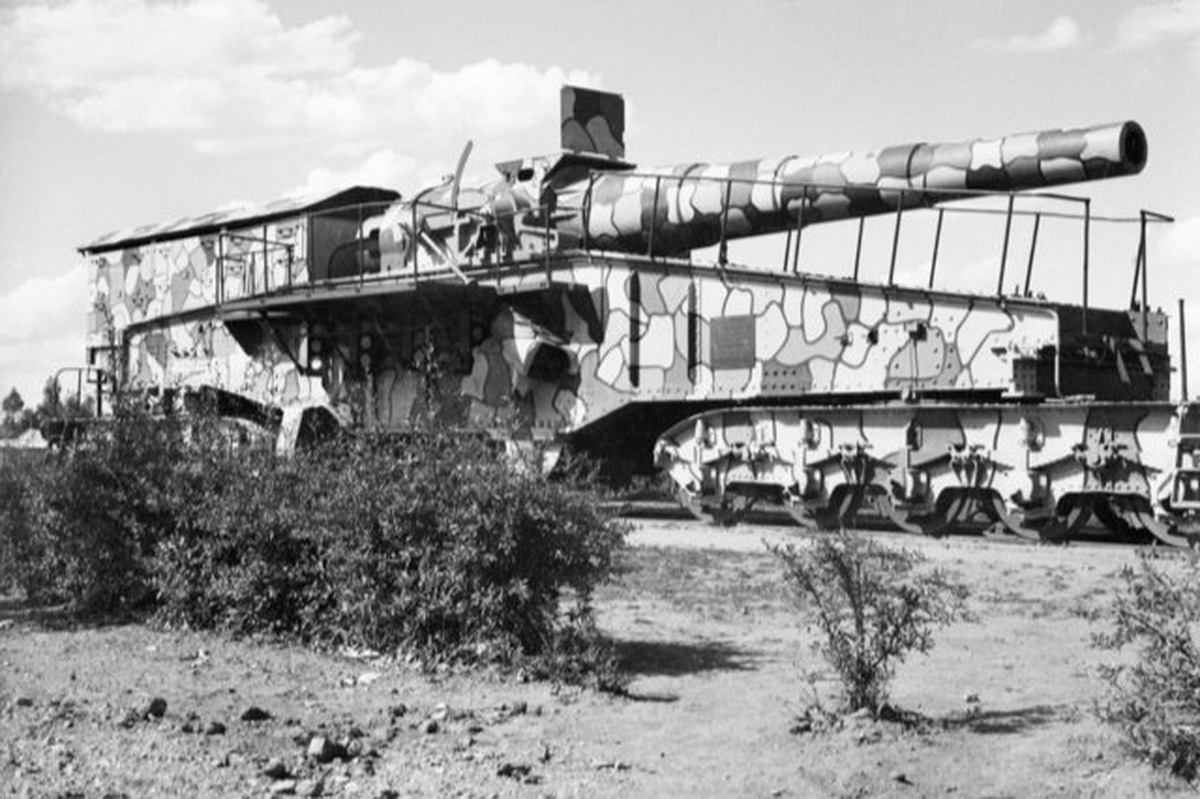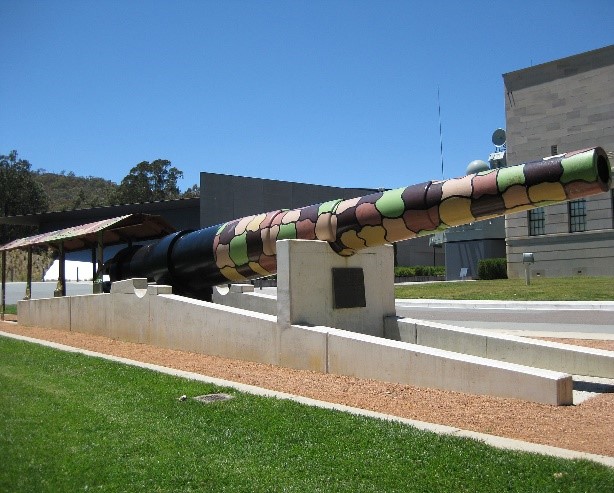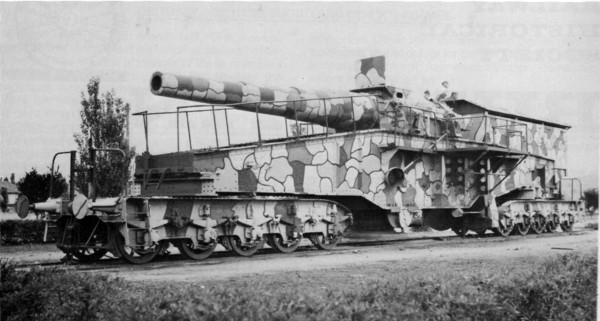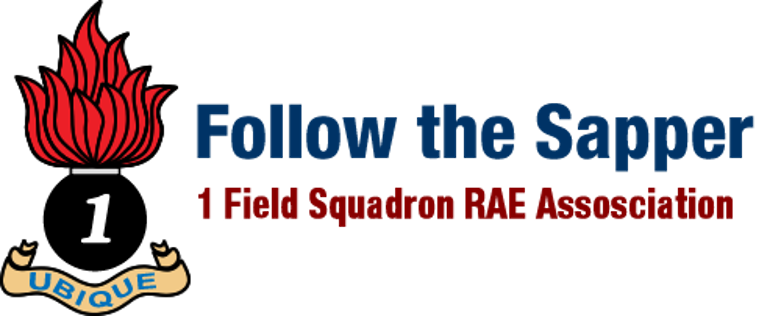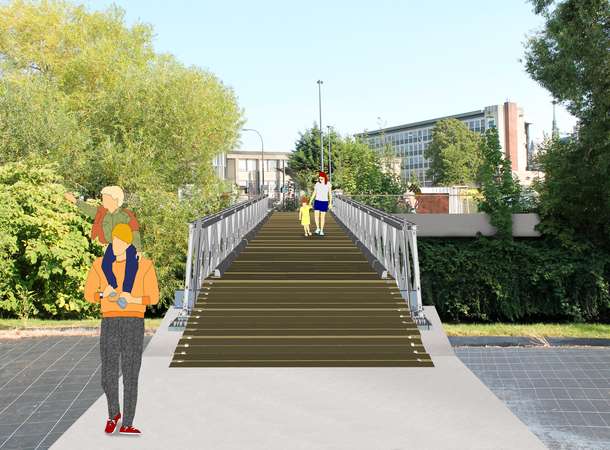1 Field Squadron Group, RAE, Qld Inc.
Amien's Bridge Memorial
Click on each tab below to read the full story of the bridge project
About Amiens Bridge
The idea to dedicate a monument to every Australian Army Engineer unit that served in World War One (WWI) was born at a reunion of the 1st Field Squadron Group RAE Association in 2015. Research into Australian Army engineer history in support of the fighting elements revealed that the Australian Sappers were involved in hand-to-hand fighting in their role as combat engineers. The units were also responsible for a host of engineering work providing mobility and sustainability resources from seaports to the front line.
During the research, it was discovered that there was a particular day when Australian Army engineers provided a staggering amount of combat support to the assaulting Australian forces. It was the first day of the Battle of Amiens – 8 August 1918. On that one day, three Australian Sappers were nominated for the Victoria Cross – the only Victoria Cross citations for Australian Army engineers during WWI that we can find. There were 15 high-level decorations awarded to Australian Army engineers on that day. There were another 13 decorations awarded to Australian Army engineers on 29 September 1918 when they helped to break through the “impregnable” Hindenburg Line.
A search was conducted to see if there was a monument to these magnificent Australian Sappers. There are none. There are memorials to a small number of Australian Army engineer units as individuals, but nothing to commemorate the Corps of Australian Engineers. A decision was made to put that right. The choice of an appropriate memorial, its location and date for dedication led the Association to suggest the memorial could be at Amiens in France where the action took place and that the date for dedication of this monument be on the anniversary of the first day of the Battle – 8 August 1918. The idea of a bridge to act as both a useful device and as a monument was mooted between George Hulse and Brigadier Wayne Budd AM CSC (Head Of Corps RAE at the time) during a meeting in Canberra. There we had it. The design, the place and the date.
The idea was introduced to the Amiens City Council who adopted it warmly from the start. The Amiens City Council have provided extraordinary support for this monument and assisted the Association over a number of years to bring it to reality. We have agreed on the provision of a Double Single Bailey Bridge adopted for pedestrian and bicycles (with wheelchair access) and some display panels to explain what the bridge is all about. The bridge has been named “The Bridge of Friendship Between Australia and France”.
The association commenced crowd fund-raising in 2019 but after an initial ground-swell of support, the donations all but disappeared due to the bush-fire and koala bear rescue appeals with which we competed in late 2019 followed by the COVID-19 pandemic of 2020.
We are still asking for financial support for this project and we encourage any donors to provide some much-needed financial assistance through Direct Debit to the project bank account. Bank details are:
Name of Account: 1 Field Squadron Group RAE
BSB: 638-060
Account No. 15136868
Your donation of two dollars or more is tax claimable.
Our charitable organisation number is CP6457.
Make sure that you add in your name because we want to
permanently record everybody’s donation going forward into perpetuity.

The RAE Corps Foundation is supporting this project and you can find details about this on their website at www.raefoundation.org.au
As a point of interest the badge used by the Australian Sappers of WWI was different to today’s Sapper in the RAE. These differences are demonstrated below. The Corps of Royal Australian Engineers change of hat badge occurred on 31 January 1936.
Details on the dedication of the bridge on 11 November 2022, the march, ribbon-cutting ceremonies, accommodation and tour guides of the nearby battlefields is given in the Latest News section of this website.
Sister Bridge at Amiens in Queensland
There is a sister bridge that is a smaller version of our Bailey Bridge in France, located in the rural township of Amiens in Queensland (near Stanthorpe). The two bridges symbolise that there is an unbreakable bond of friendship between Australia and France. Amiens in Queensland was named after the city in France by the soldier-settlers who came home from the War and established themselves in the Stanthorpe area. This bridge is located in the historical precinct of Amiens (Qld). The Amiens Historical Society under the leadership of Professor Roger Willis has created a memorial and museum space in their town that acknowledges the pioneering work done by their forebears.
Information Panels next to the Bridge in Amiens France
There are to be two information panels located next to the bridge at the Amiens City Botanical Gardens. One panel is dedicated to the English language and the other to French. The English language version may look like the concept shown below. The QR Code is linked to this website and can be accessed using a smartphone or tablet with a QR Code reader application.
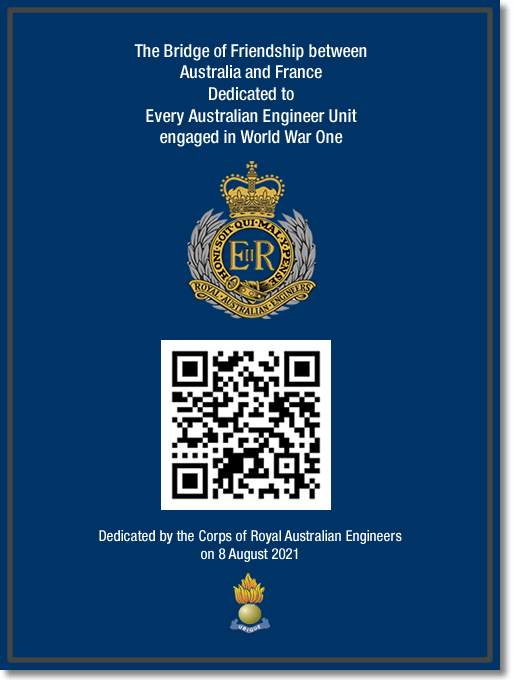
The link between the Corps of Royal Australian Engineers and our forebears in the Australian Army Corps of Engineers of WWI is a never-ending vote of gratitude and remembrance for the men that wrote their courage, resilience, innovation and determination into the DNA of today's Australian Sapper. This bridge symbolises our link with them.
Ubique.
We Will Remember Them
1 Field Squadron Veterans of the Corps of Royal Australian Engineers
Follow the Sapper
25 April 2020
Who are the Army Sappers?
We’re Everywhere – First In and Last Out!
The Motto of the Royal Australian Engineers (RAE) is “Ubique” which is Latin for “Everywhere”. In WWI the Australian Army Engineers had 28 units spread from the ports to the front lines. These were the men that ran the railways, seaports, airfields, built roads, bridges, hospitals, supplied drinking water for the men and horses, produced quarry material, produced timber sourced from forests, fabricated stuff on-the-run, ran the Signals communication system and a whole lot more. These were the men who made millions of duckboards for our forward troops to engage the horrific mud conditions mainly in the water-logged trenches. They made plank roads to cross ground that was so torn to pieces that even a mule couldn’t get through it – but the plank roads did the job and allowed trucks to pass. See the attached image with a destroyed tank in the centre and the plank road on the right of the image.
We had Australian Sappers in the Middle East where 3 FD COY was among the first of the AIF in WWI to engage the enemy in February 1915 across the Suez Canal. It was 1 FD COY that led the charge across the beach at ANZAC Cove on 25 April 1915 and it was the engineers who were last to depart that famous beach when they left on 20 December 1915. Not well-known is that the infamous charge at Beersheba may have not gone ahead had it not been for the water supplied by the Australian engineers, mainly 1 FD SQN, the night before the attack.
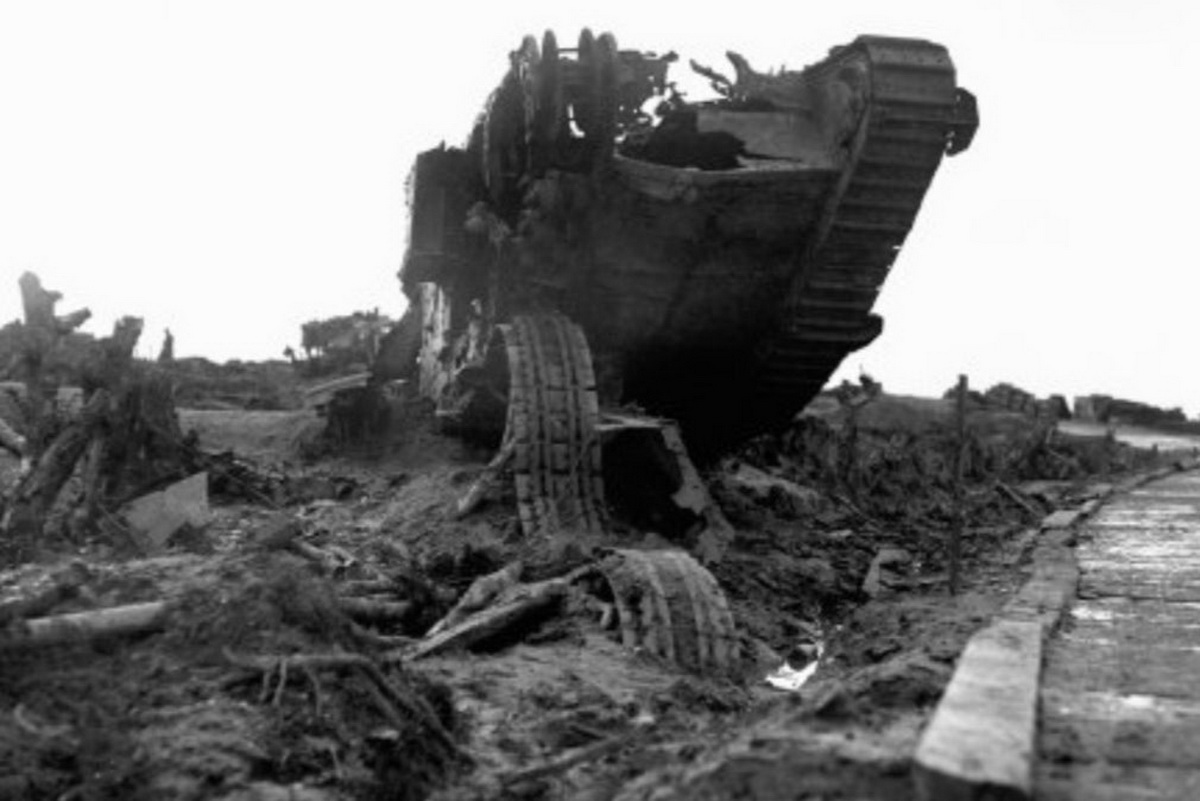
The first Australian casualties at ANZAC Cove included four Sappers of 1 FD COY. The last Australian casualties of WWI were five Sappers from the 1st Tunnelling Company (Australian Army Engineers) who were KIA building an assault bridge in early November 1918 – just days before the Armistice went into effect. Hence the term that we are “First In and Last Out”. It happens to this day. And so, we of the Corps of Royal Australian Engineers - modern day Sappers – are building a monument – a useful bridge – at Amiens in France to honour and respect our magnificent forebears.
Why are we building a bridge as a monument to the Engineers of WWI?
The Australian Army engineers (the Sappers) on 8 August 1918 in Amiens France, demonstrated incredible courage under fire, determination that you couldn't cut with a chain saw and initiative that was jaw-dropping. This was World War One (WWI). On that one day, they helped to break through enemy positions and to cap it off, literally "ripped off" an enormous railway gun from under the noses of the enemy. They received a huge number of decorations plus three citations for the Victoria Cross. From 8th August to the Armistice on 11 November 1918, the engineers were awarded 86 decorations for acts of courage in combat of which 15 were awarded on 8 August and 13 awarded on 29 September 1918. But they have never been recognised with a monument. Our team wants to put that right. To give you an idea of a couple of instances of Sapper courage and resilience, the following accounts of Sappers in combat all occurred on 8 August 1918 – the first day of the Battle of Amiens.
Sapper William CAMPBELL and Sapper Arthur DEAN
The attack that commenced at 0420hrs on 8 August 1918 was the largest and most successful Allied assault on the German Army of WWI. It remains as one of the biggest engagements in modern military history. It was delivered so swiftly and successfully that the German General Ludendorf stated that 8 August 1918 was “The Black Day for the German Army”.
The Australian Army advanced rapidly and over-ran a host of German positions quickly – with the Sappers forming a part of the leading combat element. Bridges across the Somme River were essential. A set of bridges were to be built in the villages of Cerisy and Chipilly. But the Germans still held stubbornly on to the heights of Chipilly and were making life hard for the UK and Australian troops trying to secure the river line.
A group of Sappers approached Cerisy and pushed forward to the River. Much to their delight, the bridge code-named “Cherry” was still intact and the Australian Sappers surged forward and captured it (photo below – it’s still there despite two world wars). Their other bridge mission, codenamed “Sapper Bridge”, was abandoned because it was smack in front of a German field gun firing at point-blank range. The Lieutenant left a group of a Corporal and six Sappers to guard the bridge and then took the rest of his lads to another bridge site.
Not long after he left, all hell broke loose 500 metres to the north of Cherry Bridge. Two German machine guns protected by a platoon of infantry had caught the leading company of the London Fusiliers in a deadly cross-fire. The Corporal sent two diggers forward to report – he thought that his bridge was vulnerable
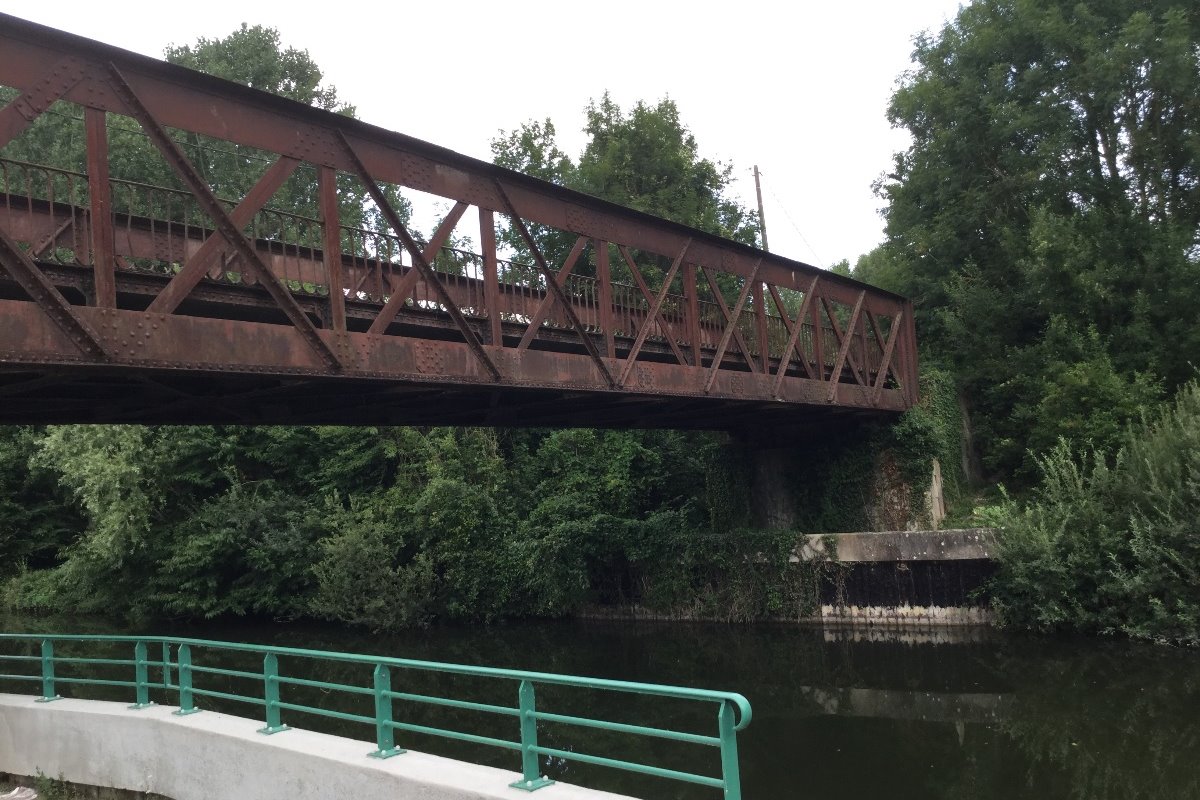
The two Sappers were Bill Campbell and his mate Arthur Dean. When they pushed up close they could see that the German machine guns were cutting the London Fusiliers to pieces. They decided to do something immediately. Using soldier skills they crept up behind the German platoon and then rushed them in a two-man assault with screams, grenades and a fusillade of rifle fire. The Germans thought that their position had been surrounded and rather than all of them being killed for no gain, they surrendered - to two Australian Sappers. The Londoners rushed forward and captured the lot.
For their troubles Bill and Arthur were written up by their Australian commanders for the Victoria Cross. But the senior British General wrote them both back to the Distinguished Conduct Medal (one below the VC). There are no photos of either digger. They came home after the war and resumed life as usual. Nobody knew what they had done on 8 August 1918.
Breakfast at Warfusee
In the Australian and Canadian areas, the forward combat elements were literally charging forward at an overwhelming speed. The Australians over-ran complete German units and stores dumps, artillery positions and headquarters and swept on toward their final objective. On their way along the Amiens to St Quentin Road (put there by the Romans almost 2000 years ago) the Australians Sappers were required to check out everything below ground level. In 1918 the Germans had set up an underground Command Centre under the main road about a kilometre or so from the town of Warfusee. The Sappers crashed through the doors of the underground facility, and much to everyone’s amazement (literally everyone) discovered five senior German officers sitting down to breakfast. They had no idea that their entire Command had just been over-run by the Australians. The Sappers captured these hapless officers, handed them over to the infantry as POW and then made short work of the Bratwurst.

Of Maps and Charts and Lists of Stores
The day continues with the Australians pushing forward in an unstoppable rampage. They hit the township of Bayonvillers and the Sappers entered into a Chateau that had been very hurriedly vacated by a German HQ. The Australian Sappers captured numerous secret tactical maps and charts showing the location and content of German stores dumps and a wealth of stores lists showing where every nut, bolt, water-well and spare railway line was located. The Australian Chief Engineer was so pleased that he personally congratulated that band of Sappers for the information they had captured. The Australians now had a mountain of stores and engineering stuff laid on as a gift by the German Army. And the day was not over yet, so they pushed forward and kept the momentum rolling.
The Big Gun
The Australian advance was a riot. They arrived at their final objective in eight hours. It was supposed to have taken four days. On arrival at Harbonnieres (the final objective) the Australians halted. But, looking out over “no-mans-land”, they saw an enormous gun mounted on a railway line. It was about 200 metres to their front and too much of a temptation not to have a go at it. Three engineer soldiers – Lieutenant George Burrows MC, Sapper Les Strahan and Sapper John Palmer decided to go and capture the gun from under the enemy’s noses. There are a couple of versions of what occurred, but the following passage was written three days after it happened and is a Citation. It reads: “For conspicuous bravery and devotion to duty. In the attack east of Villers-Bretonneux near Amiens on the 8th August, Sapper Strahan and Sapper Palmer were with a Section accompanying the assaulting Battalion. On the final objective being reached east of Harbonnieres, a long range 11.5 inch gun (actually 280mm) on railway mounting was seen on a siding 200 yards beyond front line. A locomotive with several ammunition wagons and coaches which were on fire was also on the siding. Without hesitation, these men volunteered and went forward with their Section Officer (Lieutenant George Burrows MC) and in spite of enemy machine gun and rifle fire, assisted to raise steam in the locomotive, shunt the burning coaches on to another siding, couple up with gun and ammunition wagons and bring them back safely into our own lines. Their great courage and determination in the face of the enemy resulted in the capture of an extremely valuable gun and locomotive and it is worthy of the very highest recognition”. This is taken from the records held in the Australian War Memorial in Canberra where you can see the actual gun barrel of this railway gun on display.
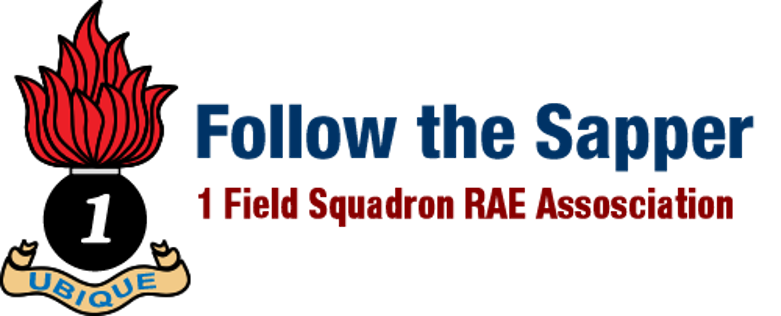
The Bridges of Friendship between Australia and France, is dedicated to every Australian Army engineer unit involved in World War One.
The Bridges of Friendship located at Toowong, Brisbane Australia, Amiens France and Amiens Queensland were financed entirely out of the generosity of the Australian people. Not one cent came from any Governmental resources despite a request for financial assistance made by the 1st Field Squadron Association.
The Association is particularly grateful for the financial support of the RAE Foundation, RSL Qld and RSL Toowong Sub Branch, the Sappers Associations of North Queensland, New South Wales, 32 Small Ships and the host of personal supporters who made this project a reality. These monuments will stand forever in perpetual memory of the magnificent Sappers of World War One.
The following list is a record of the entities who supported the monument/bridges at Toowong and Amiens France.
This list does not include salutations nor post-nominal awards.
Donor's List
RAE Foundation ... $50,000
George Hulse ... $27,500
RSL Queensland ... $20,000
RSL Toowong Sub Branch ... $10,000
Over $5,000
Jim & Aurian Weston ... $5,200
Bailey Wagner ... $5000
Over $3,000
Sandy MacGregor ... $3,500
NSW Sapper Association and John & Faye Ray Family ... $1,000/$2,000
Combined Total ... $3,000
Over $2,000
The Rotary Club ... $2,500
Wayne Budd ... $2,000
Over $1,000
Nth Qld Sappers Association ... $1,500
Wilson & Wood ... $1,100
John & Judy Kemp ... $1,100
Over $800
1st Field Squadron Association ... $1000
32 Small Ships Association ... $1000
David & Elaine Wilson ... $1000
Brian Florence ... $1000
Matthew Scott ... $1000
Aaron Zee ... $800
Over $500
Peter Krause ... $600
Peter Aylett ... $500
Matthew Duly ... $500
Adrian Lewis ... $500
John Pritchard ... $500
Reece Ward ... $500
Peter Witcomb ... $500
Over $300
Jordan Chapman ... $400
David Buring ... $350
Bruce Cameron ... $300
Warren & Trish Forbes ... $300
Mark “Foz” Forward ... $300
Mike & Donna Muirhead ... $300
Derek Smith ... $300
Daniel O'Sullivan ... $300
Aaron Zee ... $300
Over $100
John Beningfield ... $250
Tony De Bont ... $250
Robert Ihlein ... $250
John Macpherson ... $250
Nigel Meadows ... $250
Max & Beryl Goddard ... $250
Terry Ballantyne ... $200
Bronwyn Beattie ... $200
Ralph Bertinetti ... $200
Graham Cobb ... $200
Bruce Cameron ... $200
Warren Forbes ... $200
Alexander Jackson ... $200
Allan Preston ... $200
Bill Ryan ... $200
Up to $100
Roger Armfield ... $100
Paul Asbury ... $100
Blue Baker ... $100
Gary Barker ... $100
John Briggs ... $100
V Bowden ... $100
Cannington M I ... $100
Bruce Cameron ... $100
Roger Casey ... $100
Jordan Chapman ... $100
Gary Collins ... $100
Maddison Cullen ... $100
Glenn Defaveri ... $100
Ray Drews ... $100
Judy Duckett ... $100
Ewan Farquharson ... $100
Mark Fitzsimmons ... $100
Ken Ford ... $100
Bob Francis ... $100
Neil Garland ... $100
Bruce Glossop ... $100
John Hammond ... $100
Cameron Higgins ... $100
Duncan Higgs ... $100
Michael James ... $100
John Jesser ... $100
Rick Landers ... $100
Trevor Leitch ... $100
Chris Lindsay ... $100
Mark Loneragan ... $100
John & Janet McAfee ... $100
Alison Maher ... $100
Peter North ... $100
Michael O'Callaghan ... $100
Graham Peterson ... $100
Mark Plath ... $100
Alan Preston ... $100
Maxwell Rodger ... $100
Tom Ryan ... $100
Paul Ryan ... $100
Margaret Southwell ... $100
Geoff Spencer ... $100
Shane Telford ... $100
Grant Theelen ... $100
Eugene Thomas ... $100
Phil Wailes ... $100
Wiebler ... $100
Ross Williamson ... $100
David Wood ... $100
Robert Yates ... $100
Michelle Barnes ... $75
Tony Andrews ... $50
D, Atley ... $50
Bankvic ... $50
Mark Burnett ... $50
Harry Claassen ... $50
OLD FRED ... $50
Jeanne Godfrey ... $50
Mitch Honeysett ... $50
Jason Hancock ... $50
Tony Jensen ... $50
Allan Mansell ... $50
Andy & Chris Marks ... $50
Anna Lehman ... $50
Kathleen Ramsay ... $50
Paul Seidel ... $50
Dennis Stallard ... $50
Brian Sheehan ... $50
Terry Sinclair ... $50
Steve & Pauline Theodore ... $50
Jack Vinter ... $50
Keith Watts ... $50
Arend de Weger “Dutchy” ... $50
Paul Kaye ... $35
Gail Lacey ... $25
Dave Phillips ... $20
Dyan McDonald ... $20
Wendy McGuigan ... $20




